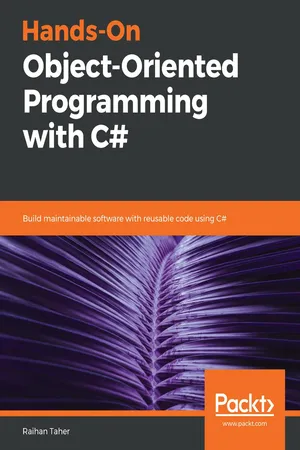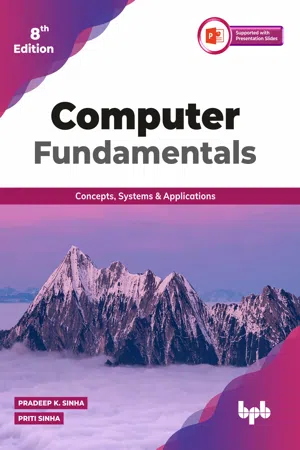Computer Science
C Sharp
C Sharp, often written as C#, is a popular programming language developed by Microsoft. It is widely used for building Windows applications, web services, and games. C# is an object-oriented language that offers strong typing, scalability, and a rich set of libraries, making it a versatile choice for software development.
Written by Perlego with AI-assistance
Related key terms
4 Key excerpts on "C Sharp"
- eBook - ePub
Hands-On Object-Oriented Programming with C#
Build maintainable software with reusable code using C#
- Raihan Taher(Author)
- 2019(Publication Date)
- Packt Publishing(Publisher)
Overview of C# as a Language
With the introduction of modern-day programming practices, it is evident that developers are looking for more advanced constructs to help them to deliver the best software in the most effective way. Languages that evolve on top of frameworks are built to enhance the capabilities of the developers in a way that allows them to quickly build their code with less complexity so that the code is maintainable, yet readable.There are many high-level object, oriented programming languages available on the market, but among them I would say one of the most promising is C#. The C# language is not new in the programming world and has existed for over a decade, but with the dynamic progress of the language itself creating so many newer constructs, it has already left some of the most widely accepted language competition behind. C# is an object-oriented, type-safe, general-purpose language that is built on top of the .NET framework that was developed by Microsoft and approved by theIn this chapter, we will cover the following topics:European Computer Manufacturers Association(ECMA ) and theInternational Standards Organization(ISO ). It is built to run on the Common Language Infrastructure and can interact with any other languages that are built based on the same architecture. Inspired by C++, the language is rich in delivering the best of breed applications without handling too many complexities in code.- Evolution of C#
- Architecture of C#
- Fundamentals and syntax of the C# language
- Visual Studio as an editor
- Writing your first program in Visual Studio
Passage contains an image
Evolution of C#
C# has been one of the most dynamic languages in recent times. This language is open source and mostly driven by a group of software engineers, whorecently came up with lots of major changes to enhance the language and provide features to handle the complexities in the languages that exist. Some of the major enhancements that have been put forward for the language include Generics - eBook - ePub
Computer Fundamentals - 8th Edition
Concepts, Systems & Applications
- Pradeep K.Sinha(Author)
- 2004(Publication Date)
- BPB Publications(Publisher)
- Java is similar to C++ with fewer features to keep it simple and easy to use. Several complex features of C++ such as pointer and multiple-inheritance are not part of Java. Hence, Java is considered a “clean” object-oriented language.
Before innovation of Java, Internet applications were static in nature because they offered visually static pages of information. The advent of Java and its use in Internet applications enabled the use of dynamic pages, allowing users to interact with what appears on the screen. Hence, Java brought animation and interactivity to Internet-based applications.Use of Java is not limited to only Internet-based applications. Programmers can also use it to develop anything from spreadsheets to tutorials to interactive games. They can also use it in embedded systems such as in consumer electronics products like hand-held devices and telephones.Java comes in two variants - Java Runtime Engine (JRE) and Java Software Development Kit (SDK). The JRE is essensially runtime environment consisting of byte-code interpreter, Java Virtual Machine, and set of basic libraries to support Java language features. The Java SDK is further bundled in two separate packages - Java 2 Standard Edition (J2SE) and Java 2 Enterprise Edition (J2EE). The former supports most of the feaures and libraries required to build a full featured Java application whereas, the latter provides advanced features like native inteface, remote invocation, Java Server Pages (JSP), etc.C#
C# (read as C Sharp) is an object-oriented programming language developed by Anders Hejlsberg and released by Microsoft. It is part of Microsoft's .NET technology initiative. It is standardized by ECMA (European Computer Manufacturers Association) and ISO (International Standards Organization). Its design was motivated by following design goals: - Mark J. Price(Author)
- 2021(Publication Date)
- Packt Publishing(Publisher)
02
Speaking C#
This chapter is all about the basics of the C# programming language. Over the course of this chapter, you'll learn how to write statements using the grammar of C#, as well as being introduced to some of the common vocabulary that you will use every day. In addition to this, by the end of the chapter, you'll feel confident in knowing how to temporarily store and work with information in your computer's memory.This chapter covers the following topics:- Introducing the C# language
- Understanding C# grammar and vocabulary
- Working with variables
- Exploring more about console applications
Introducing the C# language
This part of the book is about the C# language—the grammar and vocabulary that you will use every day to write the source code for your applications. Programming languages have many similarities to human languages, except that in programming languages, you can make up your own words, just like Dr. Seuss!In a book written by Dr. Seuss in 1950, If I Ran the Zoo- Mark J. Price(Author)
- 2020(Publication Date)
- Packt Publishing(Publisher)
02
Speaking C#
This chapter is all about the basics of the C# programming language. Over the course of this chapter, you'll learn how to write statements using the grammar of C#, as well as being introduced to some of the common vocabulary that you will use every day. In addition to this, by the end of the chapter, you'll feel confident in knowing how to temporarily store and work with information in your computer's memory.This chapter covers the following topics:- Introducing C#
- Understanding the basics of C#
- Working with variables
- Working with null values
- Further exploring console applications
Introducing C#
This part of the book is about the C# language—the grammar and vocabulary that you will use every day to write the source code for your applications. Programming languages have many similarities to human languages, except that in programming languages, you can make up your own words, just like Dr. Seuss!In a book written by Dr. Seuss in 1950, If I Ran the Zoo , he states this:"And then, just to show them, I'll sail to Ka-Troo And Bring Back an It-Kutch, a Preep, and a Proo, A Nerkle, a Nerd, and a Seersucker, too!"Understanding language versions and features
This part of the book covers the C# programming language and is written primarily for beginners, so it covers the fundamental topics that all developers need to know, from declaring variables to storing data to how to define your own custom data types.Advanced and obscure topics like ref local variable reassignment and reference semantics with value types are not covered.This book covers features of the C# language from version 1.0 up to the latest version, 9.0. If you already have some familiarity with older versions of C# and are excited to find out about the new features in the most recent versions of C#, I have made it easier for you to jump around by listing language versions and their important new features below, along with the chapter number and topic title where you can learn about them.
Learn about this page
Index pages curate the most relevant extracts from our library of academic textbooks. They’ve been created using an in-house natural language model (NLM), each adding context and meaning to key research topics.



